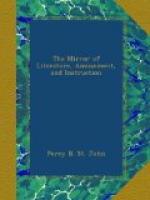“When these birds set about building their nests, they choose a clear spot, and raise it a foot and a half off the ground, upon a heap of leaves of the palm tree, which they collect together for the purpose. They only lay one egg, which is very much larger than that of a goose. The male and female sit by turns, and it does not hatch until after a period of seven weeks. During the whole period of incubation, or that they are rearing their young one, which is not capable of providing for itself until after several months, they will not suffer any bird of their own kind to approach within 200 paces of their nest; and what is very singular is, that the male never chases away the females; only, when he perceives one, he makes, in whirling, his ordinary noise, to call his companion, which immediately comes and gives chase to the stranger, and which she does not quit until driven without their limits. The female does the same and allows the males to be driven off by her mate. This is a circumstance that we so often witnessed, that I speak of it with certainty. These combats last sometimes for a long time, because the stranger only turns off, without going in a straight line from the nest; nevertheless, the others never quit until they have chased them away."[17]
[17] Voyage de Francois Leguat, Gentilhomme, Bressan, 1708.
Mr. Thompson finds this evidence strengthened by the facts and statements of a paper by Mr. Duncan, in the Zoological Journal for January, 1828; and infers that a bird of corresponding size and character did actually exist, of which the only remains are a bill and foot in the Ashmolean Museum at Oxford, and a foot in the British Museum, all of which Mr. Thompson examined on his return from the Mauritius in 1816. The specimen, which in part remains at Oxford, was originally in the museum of Tradescant, at Lambeth, which was purchased and removed to Oxford by Dr. Ashmole; the entire bird is proved to have been in the Museum in 1700; and in a catalogue of the collection drawn up since 1755, the disappearance of all but the bill and foot of the Dodo is explained by an order of a meeting of the visitors in the last-named year. Tradescant, it will be recollected, was gardener to Charles the Second; and in the portrait of him still preserved is introduced a Dodo, which belonged to him when alive. Another painting of the bird, to be seen in the British Museum, is stated by Mr. Duncan, to have been executed from a living bird, sent from the Mauritius to Holland, the Dutch being the first colonists of that island; but, Mr. Thompson thinks, “to dissipate all doubts as to its accuracy, it should be collated with a description taken from the Ashmolean specimen, should such be found to exist.”




